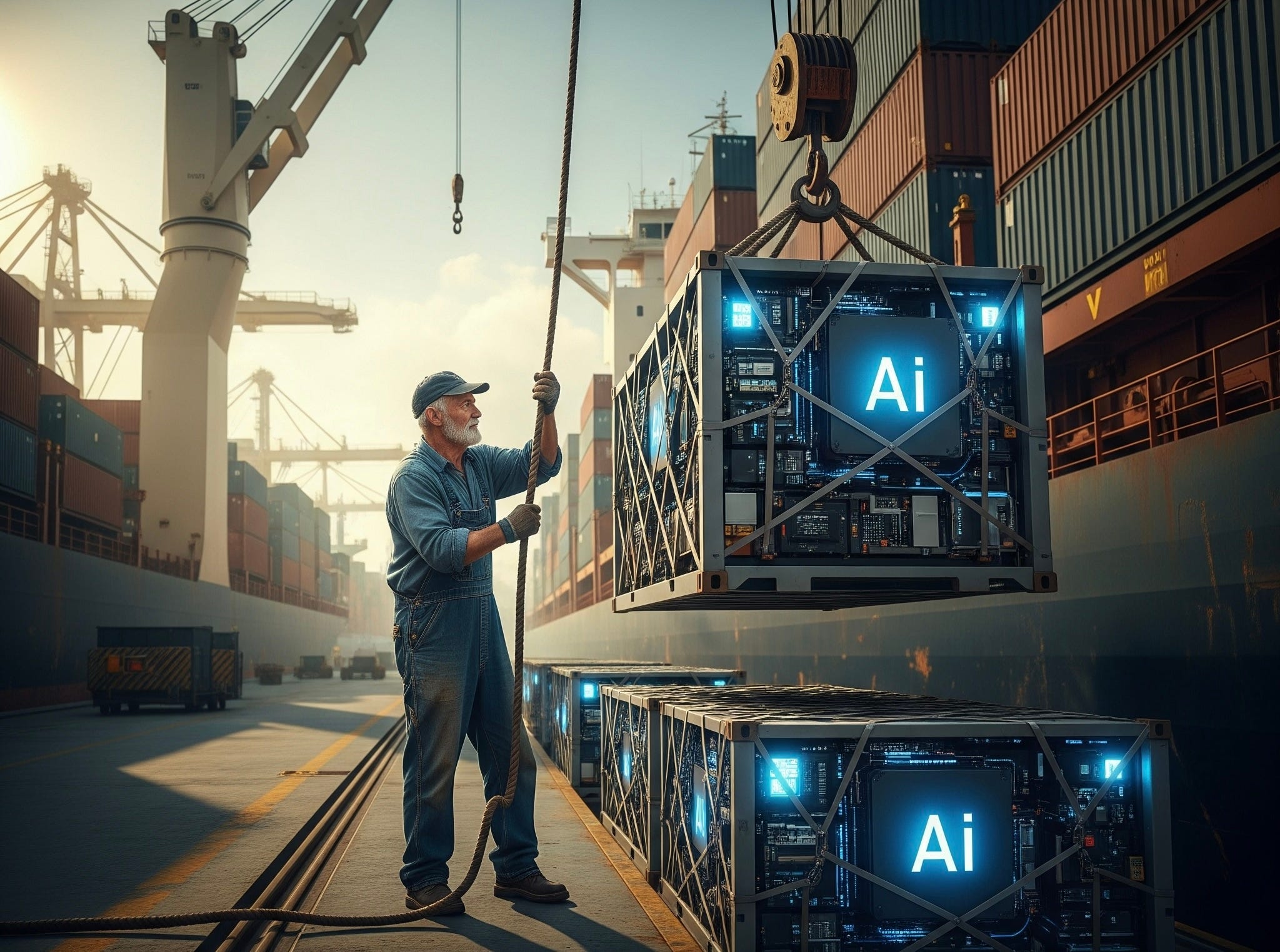Jul 1, 2025
What Does it Mean to Onshore AI?
Thinking about AI in a post-tariff global economy
July 1, 2025

Among a barrage of headlines about tariffs that are off, tariffs that are on, and questions about the future of the global economy, there’s one word that conjures the rare bipartisan agreement: onshoring. Onshoring is a familiar and popular term that refers to a country’s efforts to bring some critical nodes of a previously global supply chain onto its soil and thus more directly under its control. Global supply chains are notoriously complex and geopolitically fickle constructions built to hyper-optimize the cost of goods. Efforts are underway to bring chip manufacturing onshore thanks to generous funding from the CHIPS and Science Act . We are onshoring critical pieces of emerging technology infrastructure previously used as a lever of power by the U.S., but it is still infrastructure. If we want to dominate in a specific technology, we need to do more than onshore the infrastructure.
Onshoring chip manufacturing is not the same as onshoring AI. During the COVID-19 pandemic, many felt the direct sting of supply chain disruption . Geopolitical tensions such as China’s impending threats against Taiwan hold the potential to disrupt the supply of critical chips required for emerging technology development. The “supply chain” that develops AI has multiple nodes, not all of which are concentrated in the chip supplies. AI development, and the potential for any future global dominance, begins with the research and development strength of AI developers and their institutions and the ability for the U.S. to protect the intellectual property (IP) they create. AI also requires reliable data for training and governance frameworks that mitigate risk and ensure AI is run in a manner consistent with the individual, organization, and/or national value sets. Focusing tightly on AI infrastructure investment will result in incomplete protection of AI innovation and a gap in the goal of AI dominance.
Onshoring AI is about onshoring where AI comes from, not just what it runs on.
As the US builds new compute infrastructure and brings chip foundries onto its soil, there are other actions it must consider if it means to create dominance in AI research, development, operationalization, and monetization. Onshoring the AI supply chain starts at AI talent and intellectual property (IP) protection before it ever gets to the infrastructure. There are lessons here from previous technology competitions from which we can learn and build a plan to create lasting dominance in AI.
Subscribe now
Why Onshore AI? According to FDI Intelligence , over half of all venture capital investment worldwide in the fourth quarter of 2024 went to AI companies. According to TechCrunch , AI investments were up 62% in 2024 while investments in startups worldwide was down 12%. The sheer volume of investment in AI companies is enormous, but that’s still only part of the story.
Image Credit
According to numerous policies, executive orders, and laws, not only in the U.S. but worldwide, AI is a focus technology economically and militarily. The private and public sectors alike see the value of AI and are putting resources behind the ability to use AI for a variety of use cases. Without going into significant depth, the value and demand are both clear. As a result, where AI comes from should be something that investors and policy makers alike are looking at closely.
Since the advent of cellular phones, about every 10 years we get a new generation of technology, known as a “G.” Currently on 5G and actively building 6G, the U.S. has learned some lessons about the importance of technology standards globally. Technology standards dictate how a technology is built and operated for multiple years giving the country whose technology dominates the standard a distinct global advantage. There is no equivalent to 5G in AI. AI is not standardized the same way telecom is, but it offers an important lesson.
When DeepSeek burst onto the scene in January of 2025, many observers were shocked at how China was able to build a series of models that competed with U.S. models, doing so without the help of the most advanced GPUs . Let’s imagine for a moment that DeepSeek’s popularity had surged and consumers in the U.S. would have started using DeepSeek instead of ChatGPT or Gemini. China’s ability to control the AI market would have grown and the global AI balance would have shifted. China’s state-control of data would have been effectively exported to the U.S.
Much the same way China has limited U.S. access to its raw materials and processing technology for rare earth elements , it could likewise limit U.S. access to the best AI technology it if created this sort of dominance. If U.S. researchers did not have access to the best research or top-quality training data, the U.S. advantage in AI would quickly wither.
Where AI comes from matters.
Leave a comment
What Does it Mean to Onshore AI? The answer to this question might seem easy and perhaps already settled. Some might say that onshoring the manufacture of chips, particularly GPUs, solves this problem. Others might look at the investment by American companies Meta , Google , OpenAI , Anthropic , Microsoft , and Perplexity . You might also point to the massive $500 billion Stargate investment announced in early 2025 intended to build data centers and energy plants to power AI’s future. Those are pieces of the puzzle but do not tell the whole story. Onshoring AI is about more than the infrastructure and requires attention to critical aspects such as:
Intellectual Property Protection
Data Security
AI Talent
Computational Efficiency
Privacy
Governance
Because it matters where AI technology and innovations come from, we need to take specific actions to protect the AI we want to use. Special attention should be given to domestic AI talent as well as the protection of the IP they produce. In addition, we can no longer build AI under the assumption that it will require an ever-rising demand for compute and GPUs. Computational efficiency should be a primary concern of onshoring AI. AI is different from other technologies in obvious and non-obvious ways so how we think about onshoring it must also be different:
Building continuity and resilience in small- and large-scale uses of AI systems for domestic users.
Share
Actions Currently, investments in AI technologies are surging while research and development budgets are being cut . Immigration and student visas are matters of debate and no matter how you feel about either, the debate limits U.S. access to global AI talent. Hundreds of billions of dollars are being promised to large scale infrastructure projects (Stargate) when fractions of those investments could be spent on projects like IP protection, data assurance, and AI talent initiatives. The stakes on AI dominance are too high to only onshore a part of the AI value chain.
1. Investment in IP Protection Technologies : The U.S. government created the Disruptive Technologies Strike Force to disrupt the theft of critical IP. This effort should receive significantly more funding and personnel resources to create a true deterrent effect for human- and cyber-enabled IP theft operations perpetrated at the behest of state actors.
2. Investment in Data Security for AI : Data security is not a new technological field, but it does not receive the same level of attention as the development of new AI algorithms. Investment in data security and assurance should be at least equal to algorithm development to ensure the U.S. sustains a dominance in data quality and thus AI quality.
3. AI Talent : AI researchers and developers should have access to the best facilities and should be encouraged to push the boundaries within the lab environment. This requires a host of actions from early AI education, attraction and retention of global AI talent, and patient capital funding for R&D.
4. Computational Efficiency : We should immediately break the current view that AI will require massive data centers powered by nuclear energy to be globally competitive. Most AI use cases will require smaller, more specialized algorithms and funding should be behind creating AI that is more efficient and requires less data for better results.
Continued access to AI, under our own terms and aligned with our values, should be the goal. Onshoring AI is how this goal is achieved, and it requires more than building chip foundries. At a time when access to the global trade to which most of us have become accustomed is in question, we cannot guarantee access to the supply chains that have given us low priced goods for decades. With AI, we should consider how the global supply chain might impact our ability to operationalize and monetize AI on a geostrategic level. AI investment and national prioritization are crystal clear. How we choose to execute against that prioritization is currently incomplete. More investment should be put against onshoring AI and everything that carries with it.
In observance of Juneteenth, there will be no Frontier Foundry Substack on Thursday, June 19, 2025. We will see you next week!
Connect with us: Substack , LinkedIn , Bluesky , X , Website
To learn more about the AI products we offer, please visit our product page.
Nick Reese is the cofounder and COO of Frontier Foundry and an adjunct professor of emerging technology at NYU. He is a veteran and a former US government policymaker on cyber and technology issues. Visit his LinkedIn here .

